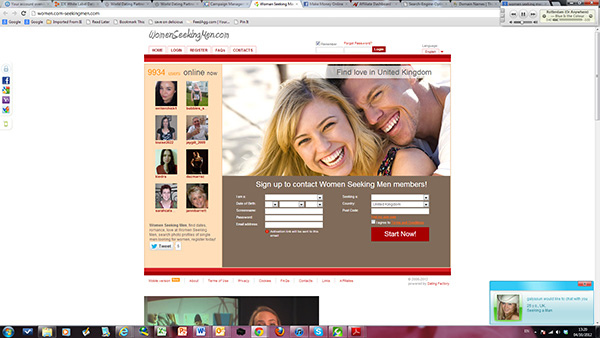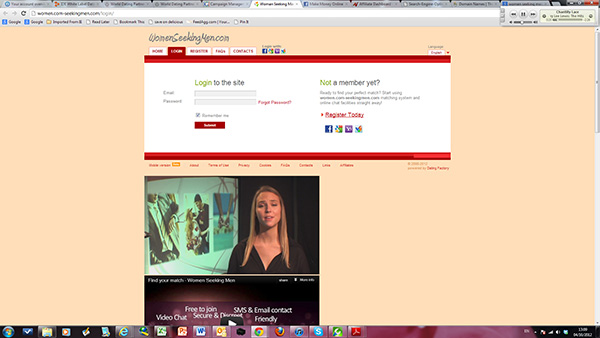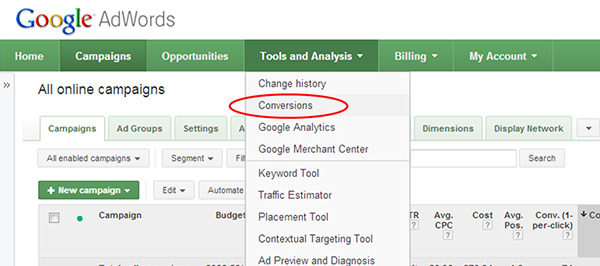In October 2012, I started an experiment on testing selected Dating Factory templates to find the best landing page for registration conversions. The objective was to gain a better understanding of click through rates (CTR) and both conversions rates and costs (CPA or cost per acquisition), based on the first touch point for the visitor. The home page, registration page and log in page were targeted in a series of Google PPC campaigns with full tracking through to registration.
The conversion results were very revealing; the conclusion from the tests is that the home page and registration pages convert better than the log in page, and in some instances the registration page out performs the home page.
One of the tests was carried out on my site Women.com-SeekingMen.com, and the results are listed below. The cost per acquisition is driven by the cost per click, which again is influenced by keyword quality score, i.e. relevance to the site, and the maximum cost per click I have set in the campaign.
Terminology:
CTR = Click Through Rate: The number of times a searcher clicks on your ad, so Clicks / Impressions
CPA = Cost Per Acquisition (or cost per registration attempt): Total Cost of clicks / Registration attempts
Conversion rate: Registration attempts / Clicks
Home page results:

AD TYPE
Plain text CTR 0.94%, CPA £0.63, conversion rate 8.12%
Keyword insertion CTR 1.63%, CPA £1.02, conversion rate 4.88%
Registration page results:

AD TYPE
Plain text CTR 0.63%, CPA £0.60, conversion rate 8.35%
Keyword insertion CTR 1.29%, CPA £0.90, conversion rate 5.15%
Login page results:

AD TYPE
Plain text ad CTR 0.66%, CPA £0.69, conversion rate 7.46%
Keyword insertion CTR 0.88%, CPA £0.98, conversion rate 5.03%
Key results for this specific campaign test:
Keyword insertion ads get higher click through rates, and slightly higher page positions, than plain text ads, but lower conversion rates, resulting in a higher CPA;
The best conversion rate is on the registration landing page from a plain text ad (8.35%, £0.60 CPA);
The next best conversion rate is on the home page from a plain text ad at 8.12%, £0.63 CPA;
The conversion rate is the highest on the registration page for keyword insertion ads (5.15%), although this type of ad performs significantly lower, at around two-thirds, of the plain text ads results;
Lowest CPA is the registration page using a plain text ad at £0.60; the highest CPA is the home page using keyword insertion at £1.02.
Before explaining how I got such great visibility on the different test page performances, I’ll give a brief overview on some Google PPC best practice and how to produce effective tracking results to enable this type of “split testing” and performance reporting to be undertaken.
Google Pay Per Click (PPC) advertising, or Adwords, is one of the few, effective paid methods of driving quality, converting traffic to dating sites, in my view. Once your site is switched live on Dating Factory’s platform, you can set up a targeted campaign with ads and keywords very quickly. As soon as it is approved by Google, which can take up to three working days, but is usually much quicker, you are in business! With regular review and considered targeting, you can make a good return on your investment, however big or small your budget.
HOT TIP: But you must segment your campaigns, track your performance and regularly review and manage every aspect of your campaigns to get the most out of this effective, but potentially expensive, channel to market. There is some degree of risk, particularly in the early days of any campaign until it settles and you get some steer from the performance stats on what is working or not.
This article is intended to share with you some of the practices that work for me; I have been working with Google PPC since April 2007, and have had my share of successes and failures. First, some basic Adwords Campaign “must do’s”:
- Google has two main advertising streams, called Search, for its own and its partners’ search engines, and Display, which uses ad space on web sites – Campaigns should be opted in to either Search or Display, NOT both; this is often overlooked but makes sense as they are two entirely different channels and you need to understand and leverage the respective costs per click and click through rates (CTR) for each;
- Adwords enables advertising on Desktops, Tablets and Mobile devices – Split out Mobile from Desktops and Tablets as separate campaigns as this will give you visibility of any differences in costs and performance for the different devices. Mobile sites look and feel different to Desktop & Tablet formats, so performance will (and does in my experience) differ.
- In your Display network campaigns, limit each Campaign to c. 50 keywords, as it is only the first fifty keywords that are referenced for search returns.
The best way I have found of both working with and editing Adwords campaigns is Google’s own Adwords Editor which is free, and can be downloaded here. This tool is especially useful if you have existing campaigns which you need to edit and replicate for different segments as outlined above. Simply copy the existing campaign, rename it and make the changes to the new campaign. Adwords Editor will also allow you to update your Adwords account with accepted changes.
When you are creating ads within an Ad group, check out the competition by entering your keyword(s) into Google and research what is returned in the search results, both at the top of the page and in the right hand column. This is where the paid ads appear. In your own ad, use call to action words like “Find your soul mate here” and “Join now for free”. Avoid excessive capitalisation and exclamation marks as Google will disallow any it considers to be “over the top”.
Set up between two and five different ads to “split test” on the same URL; do not mix URLs in the same ad group as your ad group will be disapproved – one URL per ad group. Also set your ads to rotate evenly so you are comparing like for like performance. Once you get some history, you can either manually select the best performing ads, or set Google’s optimise for clicks or conversions option. Also, try a slight rework of the best performing ad or ads so you are continually testing ads against each other.
You can copy the ad to test different landing pages for the same main domain URL, such as home, registration and login, by setting the “Destination URL” to the relevant landing page urls. This is another step in “split testing”, which is comparing the same ad against different destination pages to identify which is more appealing and relevant to searchers and which page converts best, i.e. generates more registration attempts.
You can also use keyword insertion in your ads; the syntax is easy, and can be used on any of the three available lines of an ad. This is an example for Line 1 of an ad – where there is a direct match with your keyword, the top line of the ad will be replaced by the keyword in bold in the search results. Where the keyword combination exceeds the allowed number of characters in the ad line, the default text “Find love online today” will appear:
However, unless you set up tracking on your dating site, all you will see from Google Adwords is the cost per click and the click through rate for each campaign, ad group, ad and keyword. What you REALLY want to see is the conversion rate for each. This is where the money is. You will need the conversion tracking code that Google provides, and to embed it into each site that you are advertising.
In your Adwords account, you will find “Conversions” under “Tools and Analysis”:

Click the “New conversion” button, give the conversion a name, select the default “Web Page” and the next screen appears:

I select “Sign up” under “Other”, and deselect the “Google site stats” option as a personal preference, then click “Save and continue” to generate the tracking code. On the next page, click “I generate the code” and copy the code for insertion into your site.
Dating Factory makes it very easy to insert this code – follow this tutorial to insert the code. I personally insert the conversion code for my sites in the “Registration Tracking Code” section of the “Tracking codes” page, which is the second box down.
As you start to get click throughs on your Adwords campaigns, you will also see the conversion rates and cost per acquisition performance start to build for each campaign, ad group, ad and keyword in your Adwords account. There will be more on the economics of running a PPC campaign for dating sites in a future article. Now you know how to install conversion tracking for your sites, in the next article I will reveal more of the test results for different templates in different niches. Watch this space!
Best of luck with your PPC campaigns, I hope you find the above advice and insights useful.
Remember to:
- Limit your cash exposure by setting total spend budgets at campaign level and maximum cost per click levels for keywords;
- Be prepared to invest some funds to learn about your campaign and visitor behaviour;
- Review and track continually;
- Cut underperforming campaigns, ads and keywords – the tracking is your friend, to help you drive your CPA down to your own acceptable levels of investment and return.